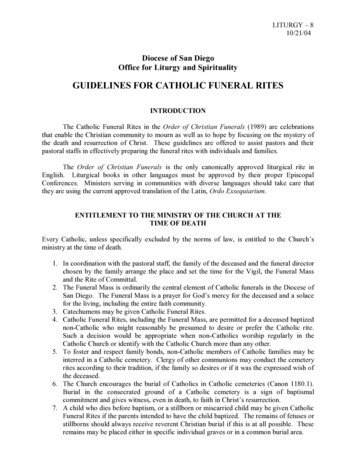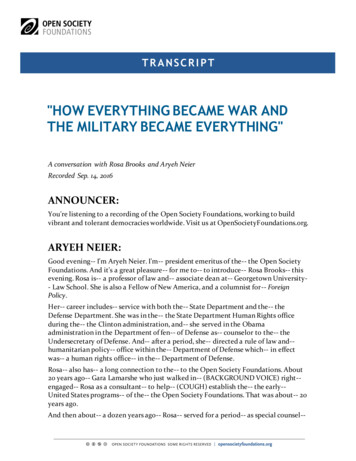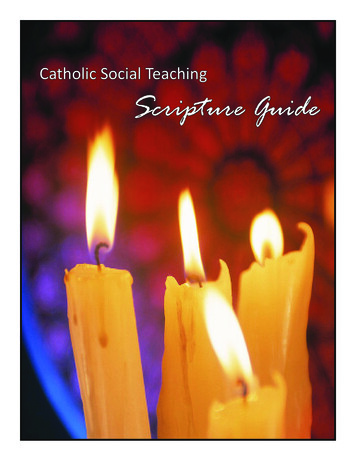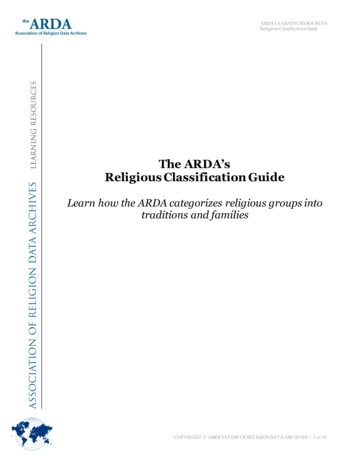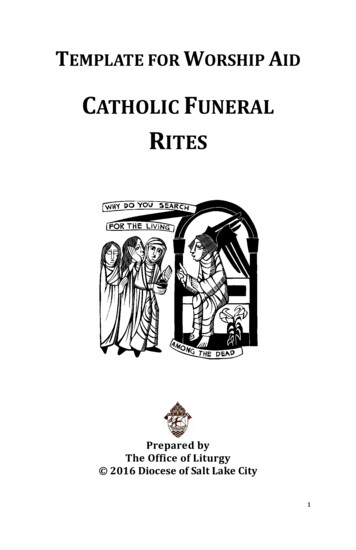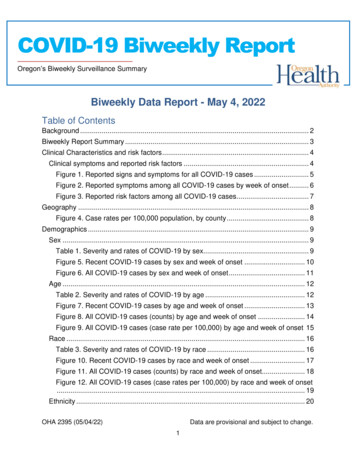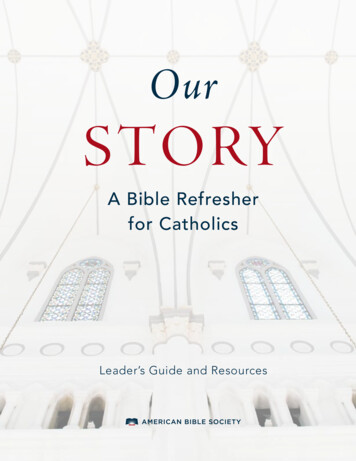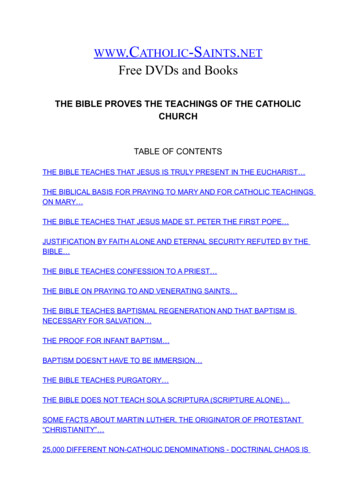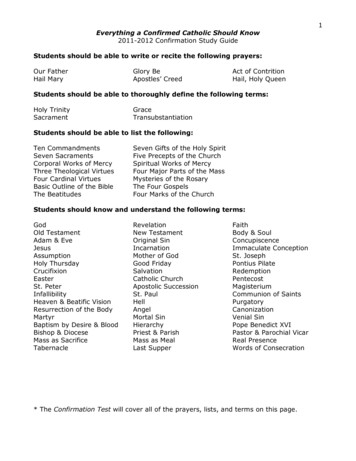
Transcription
Everything a Confirmed Catholic Should Know2011-2012 Confirmation Study GuideStudents should be able to write or recite the following prayers:Our FatherHail MaryGlory BeApostles‟ CreedAct of ContritionHail, Holy QueenStudents should be able to thoroughly define the following terms:Holy TrinitySacramentGraceTransubstantiationStudents should be able to list the following:Ten CommandmentsSeven SacramentsCorporal Works of MercyThree Theological VirtuesFour Cardinal VirtuesBasic Outline of the BibleThe BeatitudesSeven Gifts of the Holy SpiritFive Precepts of the ChurchSpiritual Works of MercyFour Major Parts of the MassMysteries of the RosaryThe Four GospelsFour Marks of the ChurchStudents should know and understand the following terms:GodOld TestamentAdam & EveJesusAssumptionHoly ThursdayCrucifixionEasterSt. PeterInfallibilityHeaven & Beatific VisionResurrection of the BodyMartyrBaptism by Desire & BloodBishop & DioceseMass as SacrificeTabernacleRevelationNew TestamentOriginal SinIncarnationMother of GodGood FridaySalvationCatholic ChurchApostolic SuccessionSt. PaulHellAngelMortal SinHierarchyPriest & ParishMass as MealLast SupperFaithBody & SoulConcupiscenceImmaculate ConceptionSt. JosephPontius PilateRedemptionPentecostMagisteriumCommunion of SaintsPurgatoryCanonizationVenial SinPope Benedict XVIPastor & Parochial VicarReal PresenceWords of Consecration* The Confirmation Test will cover all of the prayers, lists, and terms on this page.1
THE CREED2“I believe in God”“I believe in God” means that a person believes in God. Belief is the deepest convictionof mind. Belief in God is simply called faith.God is self-existing, meaning He was not created. He is eternal: God always was,always is and always will be. He is infinite, meaning He has no limitations, like a need forfood and water. God is a spirit. He is perfect. He is all-good, all-present, all-loving, allmerciful, all-just, all-holy, all-knowing (omniscient), and almighty (omnipotent).We can know God through reason. Using reason, a person realizes that the world wesee could have only been made by a Supreme Being. When we see the design, order,and beauty of creation and when we think of the precious gift of life, we are moved tobelieve in God: eternal, all-powerful, all-knowing Supreme Being who created everything.We can also know God from supernatural revelation. Revelation means that God makesHimself known to us: He communicates with us. We find revelation in the truths inSacred Scripture (the Bible) and in Tradition (the understanding and teaching of the faithsince the time of the apostles). We respond to revelation in faith.The Bible is the written Word of God, committed to His Church for the instruction andsanctification of mankind. When we say that the entire Bible is inspired, we mean that itsprincipal author is God. For this reason, we say the Bible is the Word of God.Inspiration means the Holy Spirit enlightened and guided the human authors to write allthose and only those things that He wanted to be written for the sake of our salvation.The Bible, therefore, is God‟s truth.The Bible has two parts: the Old Testament (46 books) and the New Testament (27books). The Old Testament begins with creation and tells the story of the Jewish peoplealmost to the time of Christ. The New Testament begins with the gospels (the story ofChrist‟s life), tells the history of the early Church, and concludes with the book ofRevelation.The basic structure of the Bible is as follows:Old Testament (46 Books)1. Pentateuch or Torah (Genesis, Exodus, Leviticus, Numbers, and Deuteronomy)2. Historical Books3. Wisdom Books4. Books of the ProphetsNew Testament (27 Books)1. Gospels (Matthew, Mark, Luke, and John)2. Acts of the Apostles3. Epistles4. Revelation
3We believe in one God who has been revealed as three divine persons: Father, Son, HolySpirit. The Holy Trinity is one God, three divine persons: God, the Father; God,the Son; and God, the Holy Spirit. They are one because they share the samedivine nature. They are equal but distinct. They exist from all eternity, and so areeternal. This is a mystery which we do not fully understand and which we could not knowon our own; only through revelation do we know this and believe it through faith.“the Father Almighty, creator of heaven and earth”God created everything, and is the Supreme Being above all creatures. God did notcreate the world from materials, but created it from nothing. God created even that fromwhich created is made. Traditionally speaking, God created ex nihilo, that is He createdfrom nothing. He created the world and everything in it with purpose, according to Hisdesign, and of His own freewill. God did not have to create, but because of His perfectlove, He created.Creation climaxed when God created man and woman in His own image and likeness. Noother creature is made in God‟s image and likeness; therefore, each person has a specialrelationship with God and a special dignity. This “image and likeness” also means thateach human being has a body, a physical being of a person, and a soul, a spiritualbeing. While a person‟s parents in union with God create the physical body, God Himselfcreates the soul at the time of conception. The soul is immortal; when we die, eventhough our body dies, our soul lives on and stands in judgment before God.According to the Bible, Adam and Eve were the first man and woman created by God.They had a special graced relationship with God. Because of their sin of disobeying God'scommand and wanting to be God, they lost this graced relationship. We call this first sinthe Original Sin. Original Sin has been passed onto to every generation; each person isborn with this Original Sin. Unlike other sins which we commit, Original Sin is a weaknessin our human nature whereby like Adam and Eve we reject God‟s will and want to beGod. Jesus came to restore the graced relationship, freeing us from sin and deaththrough His sacrifice on the cross and His resurrection. We now benefit from what Christdid through Baptism, a sacrament which washes away all sin, both Original Sin and anyother sins, and infuses the life of God in our souls. Nevertheless, even after Baptism, westill have concupiscence, that weakness in our human nature which still makes ussusceptible to temptation; only with God‟s grace can we overcome weakness andtemptation.“and Jesus Christ, His only Son our Lord, who was conceived by the Holy Spirit,born of the Virgin Mary”Jesus is the second person of the Blessed Trinity. Jesus is the Savior of all mankind.Jesus means “savior.” Christ or Messiah means “anointed.” In God‟s plan, the HeavenlyFather sent Jesus, His only begotten Son, into this world to free us from sin and to openthe gates of Heaven. Here then is the mystery of the Incarnation: By the will of theFather, Mary conceived by the power of the Holy Spirit, and Jesus Christ, true God fromall eternity, entered this world becoming also true man. Jesus is a divine person with twonatures: a human nature and a divine nature. Jesus retained His divine nature and alsotook on a human nature. He is one like us in all things but sin: Jesus was born withoutsin and never sinned. In this way, Jesus is true God and true man.
4Mary is a model of faith for each of us. At the Annunciation, the Archangel Gabrielrecognized her as “full of grace.” We believe that she was conceived and born free ofOriginal Sin; we call this belief the Immaculate Conception. Since Mary shared in herSon's life and was sinless, at the end of her life she was taken body and soul into Heavenwith our Lord; we call this the Assumption. We also call Mary the Mother of God, orTheotokos in Greek, meaning that Mary is the mother of the person, Jesus, the secondperson of the Blessed Trinity and true God.St. Joseph is the foster father of Jesus Christ, not the natural father. He was a very holyman. Remember that God, the Father, entrusted St. Joseph with the care of His onlySon. As a good Jewish father, St. Joseph taught Jesus the trade of carpentry and how toread and write. St. Joseph also provided a home for Mary and Jesus.“suffered under Pontius Pilate, was crucified, died, and was buried. Hedescended into hell; the third day He rose again from the dead; He ascendedinto heaven, is seated at the right hand of God the Father Almighty; from thenceHe shall come to judge the living and the dead”Pontius Pilate was the Roman governor of the province of Judea under Tiberius Caesar.He ordered the execution of Jesus after He was brought to trial by the Jews. Crucifixionis a very painful type of execution whereby a person is first tortured with scourging andthen nailed on a cross to die a slow death of suffocation. Jesus died on the cross onGood Friday.Why did Jesus have to die on the cross? Although Jesus died an awful death, webelieve that He offered the perfect sacrifice for our sins. The Jewish people believed thatsin violated God‟s law, offended Him, and separated a person from His love. For the sinto be forgiven, the person had to offer a sacrifice: by offering a sacrifice, like a lamb, sinwas washed away and the person was reunited with God. However, because sin hadgrown so much, no longer could any sacrifice offered by a person forgive the sin.Instead, only the divine action of God Himself could offer such a sacrifice; but since sin iscommitted by a human, it would also take the action of man. Therefore, Jesus, who istrue God and true man, is the only one who could offer the perfect sacrifice for all sin forall time-- past, present, and future-- and bring mankind back into union with God.However, Jesus did not just die in sacrifice, He rose from the dead giving all who believethe promise of everlasting life.There are two important terms to remember:Redemption: Jesus redeemed us from sin. He offered His suffering and death tothe Father out of total obedience and love to the Father for all mankind so that oursins would be forgiven and we would have eternal life with God in heaven. Wewere slaves to sin, and Jesus paid the price to buy our freedom. Just as a personhas to pay a price to a pawn broker to “redeem” a piece of merchandise, so Jesuspaid a price for us to be redeemed from the slavery of sin.Salvation: Because of Jesus' death and resurrection, we have salvation.Salvation is being one with God; it is sharing His life and being in union with Him inHeaven forever when we die.
5When we say Christ descended into hell, we do not mean "hell" as we know it: a place ofeternal punishment for the devil, the fallen angels, and those who have no love for God.Rather, before our Lord's passion, death, and resurrection, all of those who died went tohell, as in the land of the dead. The Jewish name for this was “Sheol.” Here there was aplace of punishment for the wicked, and a separate place of waiting for those who lovedGod and awaited the Messiah and Savior--people like Abraham, Moses, and Isaiah waitedhere. Therefore, when we say, “Jesus descended into Hell,” we mean that He descendedinto a place of rest where the souls of the just were waiting for Him. Jesus showed themthat the sacrifice for sin had been made and the gates of Heaven were now open; Hethen took the faithful souls who were waiting to go to Heaven.The Resurrection occurred on Easter Sunday. Because of Jesus' love and obedience tothe Father, the Father raised Jesus from the dead so that they would be united perfectlyin Heaven. Jesus was raised body and soul; His whole person was raised. However, Hewas not a resuscitated corpse, but had risen to a glorified and perfected life.Forty days after Easter, Jesus ascended to Heaven, returning to His Father. TheAscension of our Lord into Heaven fulfills the promise that He has prepared a dwellingplace there for each person who believes and dies in the faith.When we say that Christ sits at the right hand of God, the Father Almighty, we mean thatour Lord as God is equal to the Father. He shares above all the saints in the glory of HisFather and exercises for all eternity the supreme authority over all creatures. The Jewishpeople always considered the right hand a special place of honor and a place of equality.When we say that Christ will come to judge the living and the dead, we mean that on thelast day at the end of time, our Lord will come to pronounce a sentence of eternalreward or eternal punishment on everyone who has ever lived in this world.“we believe in the Holy Spirit”The Holy Spirit is the third person of the Blessed Trinity. The Holy Spirit dwells in theChurch as the source of life and sanctifies souls through grace. (Sanctify means tomake holy.)Fifty days after Easter, at Pentecost, the Holy Spirit descended upon the apostles gavethem special gifts. The gifts of the Holy Spirit are fear of the Lord, piety, knowledge,understanding, counsel, wisdom, and fortitude.The Holy Spirit also strengthens us with virtues. A virtue is a strength and a good habitwhich helps us to avoid evil and do good. The three theological virtues are faith, hope,and charity.FaithHopeCharity-the belief in Godthe trust in Godthe love of God and neighborBy faith, we firmly believe all the truths God has revealed, as found in the Bible andSacred Tradition. Through faith, we have hope: a firm trust in God who is all-powerfuland faithful to His promises, and who in His mercy gives us eternal happiness and themeans to obtain it. By charity, we love God above all things and our neighbors asourselves. These gifts and virtues help us by making us more alert to do the will of God.
We also practice the Four Cardinal Virtues:6PRUDENCE helps us to do good and avoid evil by making correct decisions in life.FORTITUDE gives us strength and determination in living our faith by loving Godand one's neighbor. It gives us courage to defend our faith and face persecution.JUSTICE inspires us to respect the rights and dignity of all human beings.TEMPERANCE helps us to enjoy pleasures with moderation and to use thingswisely. It helps us to become mature, disciplined Christians.These are called “cardinal virtues” because every other virtue, such as patience orhumility, depends upon them. The word cardinal means “hinge” in Latin, so these fourvirtues are the ones upon which the others “hinge.”“the holy, catholic church”We call the Church “the mystical Body of Christ.” We are united to Christ into one bodythrough our Baptism. The Church is a community of believers. Through our Baptism,we believe that Jesus is our Lord and Savior. Through Baptism, we are His adopted sonsand daughters. Christ is the head of the Church; those baptized living people and thosewho are in Heaven and Purgatory are members of the mystical body.The Church is called “the Catholic Church” because in the year 100, St. Ignatius ofAntioch used the word catholic, which means “universal,” to describe this one Church ofall Christians. Ever since that time, our Church has been called “the Catholic Church.”Officially, it is also called “the Roman Catholic Church” because St. Peter was the firstBishop of Rome, the capital of the Roman Empire, and to this day, the Pope is the Bishopof Rome.Jesus is the founder of the Catholic Church and its head. Jesus wanted His missionto continue, so He entrusted His authority to the apostles at the Ascension to go out,preach the gospel, makes disciples of all people, and baptize. St. Paul is the greatapostle who evangelized the Gentiles. The Pope is the leader of the Church on earth andis Christ's Vicar or representative. St. Peter was the first Pope. Jesus said, "Peter, youare rock and upon this rock I will build my Church." Ever since the time of St. Peter, theChurch guided by the Holy Spirit has chosen a successor to be Pope. Therefore, PopeBenedict XVI is the successor of St. Peter. By the action of the Holy Spirit, the Pope ispreserved from error when he declares a dogmatic teaching on faith or morals; this iscalled Papal Infallibility.The Bishops are the successors of the apostles, who were the first bishops. Theauthority given to the apostles by Jesus has been handed down from bishop to bishopthrough the Sacrament of Holy Orders. This handing down of authority is calledapostolic succession. Keep in mind that the Pope is also the Bishop of Rome.
What is the difference between the Catholic Church and other Christian religions?71. We believe that the Catholic Church was founded directly by Jesus, whoappointed St. Peter as the first Pope. The authority of St. Peter has been handeddown and rests with our present Pope. The Orthodox Church did not officially existuntil the year 1054 when they broke away from the Catholic Church; however, theOrthodox Churches do have apostolic succession. The Protestant churches, whichare more accurately called ecclesial communities, did not exist until 1517 at theearliest when Martin Luther started the Protestant Reformation.2. We believe that the fullness of God's revelation and the understanding of thatrevelation rests within the Catholic Church.3. We believe that the sacraments give great graces which unite us in life and lovewith God now and prepare us for our perfect union in heaven.4. We also worship at Mass. The Mass unites us with the everlasting, ever-presentreality of the Lord‟s passion, death, resurrection, and ascension.Consequently, we believe that the fullest means of salvation subsists in or rests within theCatholic Church. This does not mean that others cannot be saved; salvation is granted toanyone who truly believes in God and tries to follow the will of God, or to those whothrough no fault of their own do not know God but try to lead good lives as they knowbest. Nevertheless, the fullest means of salvation which comes to us through the Mass,the sacraments, and the teachings of Church are available only in the Catholic Church.The Four Marks of the Church are one, holy, catholic, and apostolic:1. The Church is ONE because all of its members profess the same faith, have thesame sacraments, and are united under the leadership of the Pope.2. The Church is HOLY because it was founded by Jesus Christ and because itteaches according to the will of Christ holy doctrines and provides the means ofleading a holy life for its members. The members of the church also continue themission of Jesus, pray, and worship, thereby bringing about holiness.3. The Church is CATHOLIC which means universal. The Church is Catholic oruniversal because it is destined to last for all time and strives to fulfill thecommand of Jesus to teach all truths revealed by God. Also, the Church isuniversal because it includes all of the faithful on earth, in Heaven, and inPurgatory.4. The Church is APOSTOLIC because it was founded by Christ who entrusted Hisauthority to the apostles. This authority has been handed on from bishop tobishop; this handing on is called “apostolic succession.”“the communion of saints”The Communion of Saints refers to the union of the faithful on earth (Church Militant),the souls in Purgatory (Church Suffering), and the blessed in Heaven (ChurchTriumphant) with Jesus Christ as their head. We are all called to be saints, and to live alife like Jesus. Those individuals who have led very good and holy lives are often formallydeclared saints by the Church and are models for us to follow. The declaring of a person
8as a saint by the Church is called canonization. Keep in mind that everyone in Heavenis a saint; however, the Church only gives that official title to those who have beencanonized. Those saints who died in defense of the faith are called martyrs; St. Stephenwas the first martyr of the Church.Heaven is a place and state of eternal happiness in union with God. In Heaven, we willsee God “face to face.” No longer will there be any confusion, doubt, ormisunderstanding. This special seeing God face to face is called the beatific vision.Also present in Heaven are the angels, who are pure spirits and messengers of God.God gives each person a special guardian angel to protect them.Hell is a place and state of eternal punishment of the fallen angels and those who die inthe state of mortal sin, who have rejected the love of God, and who have no sorrow forsin. People really place themselves in Hell because they refuse to seek forgiveness fortheir sins and have turned away from God.Purgatory is the place of temporary punishment where the souls of those who die in thestate of grace must be cleansed of venial sin or the hurts caused by sin. In justice, Godholds us accountable for our venial sins or the hurt caused by sin; in His love, he purgesor cleanses our soul so that we can be united with Him in Heaven. To have the beatificvision, the soul has to be perfect-totally free of sin and the hurt caused by sin.“the forgiveness of sin”God has given the Church, through Jesus, the power to forgive sins, no matter howgreat, if the sinner is truly sorry and promises to amend his life. This forgiveness comesespecially through the Sacrament of Penance when a person makes a good confessionand receives sacramental absolution.“the resurrection of the body, and life everlasting”At the end of time, there will be the resurrection of the body, when we will be unitedbody and soul in Heaven with Jesus. Just as Jesus rose and ascended body and soul intoHeaven, so will we. Just as Jesus after the resurrection could appear and disappearsuddenly, eat a meal and be touched, so will our own bodies undergo a glorioustransformation.For those souls who have already died and have been judged, they will be united to achanged body that is immortal and incorruptible. For those souls in Heaven, their bodieswill be glorified, meaning totally spiritualized, without any defect, suffering, or death.The souls in Purgatory will be finally purged and taken to Heaven where they too willhave a glorified body.The souls in Hell will be united with their body, which will be immortal and incorruptible,but they will have pain and suffering.The faithful on earth who have not died will be glorified body and soul in Heaven.
THE SACRAMENTS9A sacrament is an outward sign instituted by Christ to give grace. We believe thatthere are seven sacraments: Baptism, Confirmation, Penance, Holy Eucharist, HolyOrders, Matrimony, and Anointing of the Sick.1. A sacrament is a sign. Signs are things or actions which convey an idea. A smileor a frown is a sign of one's feelings. A flag is a sign of a nation. Words are signswhich convey an idea. In the sacraments, the words together with the action andthe materials used constitute the sacred sign. The words or prayer of thesacrament is called the form, while the action part using something material (likewater or oil) is called the matter.For example, in Baptism, the priest pours water three times over the head of theperson (the matter) while saying the prayer, “I baptize you in the name of theFather, and of the Son, and of the Holy Spirit” (the form).The sacraments are signs which not only communicate an idea but also producewhat they signify. The sacraments not only make us aware of the divine life butalso actually produce this life within us.2. A sacrament is instituted by Christ. Jesus Himself gave us the sacraments, andthey are instruments by which He is now present with us and through which heshares His divine life with us. Each of the sacraments can be traced back to whatJesus Himself actually did or said to do.3. A sacrament gives grace. Grace is a supernatural gift from God forsanctification (to make holy) and salvation (to bring into union with God). Godgives us grace freely; we do not deserve it.1) The sacraments give a special grace called sanctifying grace, which issimply the life of the Holy Trinity. Through the reception of the sacraments,we share in the life of the Holy Trinity.2) The sacraments also give actual graces. Actual grace is that grace whichenlightens the mind and strengthens the will to do good and avoid evil.3) Each sacrament gives its own special sacramental grace; each sacramentis different and offers a unique sharing in the life of the Lord. For example,when a couple is married, they receive a special grace to live the sacramentas husband and wife.If a sacrament is properly received, it will always give grace, provided the individual doesnot place an obstacle in the way, such as being in a state of mortal sin. The individualmust have faith and believe in the sacrament, and be in a state of grace (free of mortalsin). In order to receive Confirmation, Holy Eucharist, Anointing of the Sick, Holy Orders,and Marriage lawfully, the individual must be in the state of sanctifying grace, that iswithout mortal sin. One who receives any of these sacraments in a state of mortal sincommits a sacrilege, a very serious sin. If an individual is in the state of mortal sin, heshould receive Reconciliation first.
The sacraments of Baptism, Confirmation and Holy Orders are called charactersacraments because these sacraments leave a permanent mark or character on thesoul; for this reason, these sacraments are only received once.10The sacraments of Baptism, Eucharist, and Confirmation are called sacraments ofinitiation because through these sacraments we become full members of the Church.BAPTISMBaptism is the sacrament by which Original Sin and all sin is washed away,sanctifying grace is infused into the soul, and a person becomes a child of God, amember of the Church, and a sharer in the saving mystery of our Lord’s passion,death, and resurrection.Matter: Pouring of water or immersion in waterForm: “I baptize you in the name of the Father, and of the Son, and of theHoly Spirit.”Basis in Scripture:“During that time, Jesus came from Nazareth in Galilee and was baptized in the Jordan byJohn. Immediately on coming up out of the water, He saw the sky rent in two and theSpirit descending on Him like a dove. Then a voice came from the heavens: "You are mybeloved Son. On you my favor rests.” (Mark 1:9-11)Before Jesus ascended into heaven, He said, “full authority has been given to me both inheaven and on earth; go, therefore, and make disciples of all the nations. Baptize themin the name of the father, and of the Son, and of the Holy Spirit.' Teach them to carryout everything I have commanded you. And know that I am with you always, until theend of the world!” (Matthew 28:18-20)“Are you not aware that we who were baptized into Christ Jesus were baptized into Hisdeath? Through baptism into His death, we were buried with Him, so that, just as Christwas raised from the dead by the glory of the Father, we too might live a new life. If wehave been united with Him so that just as Christ was raised from the dead by the glory ofthe Father, we too might live a new life. If we have been united with Him throughlikeness to His death, so shall we be through a like resurrection.” (Romans 6:3-11)Effects of Baptism:1. Washes away Original Sin and all sin and infuses the divine life of God inour souls. Baptism is the sacrament of rebirth through which Jesus gives us thelife of God in sanctifying grace. Original sin is our inherited condition from the sinof Adam and Eve by which we are born without grace and inclined to loveourselves more than God. Original Sin leaves us with a darkened intellect andweakened will-- we face temptation and do not always choose to do what is goodand right. This weakness caused by Original Sin is called concupiscence. Whilebaptism washes away Original Sin, concupiscence remains. We always need God'sgrace to overcome concupiscence. In the case of adults, baptism removes notonly Original Sin, but also any other sin and the punishment due to sin.
2. Makes us members of the mystical body of Christ. Through Baptism, webecome members of the Church. For instance, when someone is baptized in theCatholic Church, he is considered a Catholic. St. Paul wrote, “There is but onebody and one Spirit, just as there is but one hope given all of you by your call.There is one Lord, one faith, one baptism; one God and Father of all, who is overall, and works through all, and is in all.” (Letter to the Ephesians 4:4-6)113. Makes us the adopted sons and daughters of God. Through Baptism, wehave a special relationship with God. St. John wrote, “See what love the Fatherhas bestowed on us in letting us be called children of God! Yet that is what weare.” (I John 3:1)4. Gives us a share in the passion, death, and resurrection of Jesus. ThroughBaptism, we are plunged into the paschal mystery of Jesus. We now share in thebenefits of the saving act of His passion, death, and resurrection. We are nowcalled to live a life like Christ‟s.The normal way of baptizing is with water, following the proper matter and form.However, we also believe in two special types of Baptism: desire and blood. Anunbaptized person receives the baptism of desire when he loves God above all thingsand desires to do all that is necessary for his salvation, but has never really been taughtthe faith or been raised in the Church. Many people in the world have never had theopportunity to learn about Jesus or the Church; nevertheless, these people have livedgood lives and searched for God in their hearts. Because of their desire, they too maygain entry to Heaven by God‟s grace.An unbaptized person receives the baptism of blood when he suffers martyrdom for thefaith of Christ. In the early Church during the Roman persecution, sometimes peoplewho were studying to become baptized and become members of the Church werearrested and executed; their martyrdom was a testimony of their faith, so we believethey were baptized by “their blood.”Practical Point: Anyone can baptize in the case of emergency by pouring water over thehead three times and saying, “I baptize you in the name of the Father, and of the Son,and of the Holy Spirit.”CONFIRMATIONConfirmation is the sacrament through which Jesus confers on a person thefullness of the Gifts of the Holy Spirit, thereby making us full members of theCatholic Church.Matter: Anointing with Holy ChrismFo
books). The Old Testament begins with creation and tells the story of the Jewish people almost to the time of Christ. The New Testament begins with the gospels (the story of Christ‟s life), tells the history of the early Church, and concludes with the book of Revelation. The basic structure of the Bible is
